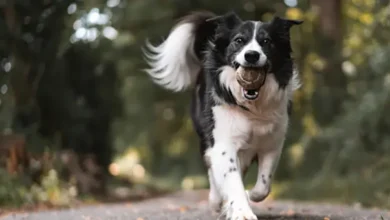How many words can a dog learn? 6 Shocking Truths You Need

MixbreedDogs.com is an Amazon Associate, and we earn from qualifying purchases.
Have you ever noticed your beloved dog tilting their head when you talk, like they’re genuinely trying to understand every word? Well, here’s something that’ll blow your mind—you’re probably right! If you’ve ever wondered “How many words can a dog learn?” you’re in for a surprise. Your dog can actually understand around 165 words, which is about the same as a curious two-year-old toddler. I know, right? That’s way more than most people think! But here’s the thing—some dogs are absolute word wizards who can learn hundreds, even thousands of words.
Whether your dog is a Border Collie genius or a lovable Golden Retriever, they’re processing language in ways that’ll completely change how you see them. Ready to discover six mind-blowing truths about your dog’s hidden language superpowers? Trust me, you’ll never look at those head tilts the same way again.
Truth #1: Dogs Understand As Many Words As Toddlers
Get ready to be amazed! Your furry friend is basically a walking, barking toddler when it comes to understanding words. Dr. Stanley Coren, a leading canine researcher, discovered something incredible through his studies.
The Amazing Numbers Behind Dog Vocabulary Size
Here’s what the research tells us about your dog’s language skills:
- Average dogs understand 165 words – that’s like having a conversation with a 2-year-old child
- Smart dogs can learn 250+ words – some pups are genuine word wizards
- Even “slow learners” know 15-50 words – every dog has language potential
What This Means for Your Daily Life
Think about it – when you say “walk,” “treat,” or “car ride,” your dog isn’t just responding to your excited tone. They actually know what those words mean! This canine language comprehension explains why your pup gets excited before you even grab the leash.
Your Dog’s Mental Dictionary
Just like toddlers, dogs organize words into categories:
- Action words: sit, stay, come, walk
- Object names: ball, toy, food, bed
- People: mom, dad, grandma
- Places: park, home, car
The Sweet Spot
Most family dogs fall somewhere between 50-165 words. That’s plenty for meaningful communication and explains why your dog seems to “get” you so well. Pretty amazing for our four-legged family members, right?
Truth #2: “Super Dogs” Can Learn 250+ Words
Did you know that about 20% of dogs fall into what researchers call the “super dog” category? These amazing pups can learn and remember over 250 words! That’s like having a walking, tail-wagging dictionary in your living room.
The Smartest Dog Breeds That Excel at Learning
When it comes to smartest dog breeds with incredible intelligent dogs vocabulary, these three consistently top the charts:
Border Collies
- Natural problem solvers
- Can learn new words in just a few repetitions
- Excel at understanding object names and commands
Poodles
- Quick learners with excellent memory
- Great at picking up complex multi-step commands
- Respond well to positive reinforcement training
German Shepherds
- Strong focus and attention span
- Excel at both verbal and hand signal commands
- Natural ability to understand context
Meet Rico: The Word-Learning Wonder Dog
Here’s a real-life example that’ll amaze you. Rico, a Border Collie from Germany, could identify over 200 different toys by name! His owners would say “Rico, get the soccer ball,” and he’d pick the right toy from a pile of dozens. Even more impressive? Rico could learn new words through a process called “fast mapping” – the same way children learn language.
What made Rico special:
- Remembered word-object connections for weeks
- Could infer the names of new objects
- Showed human-like learning patterns
The best part? Your dog might have this same potential waiting to be unlocked!
Truth #3: Some Dogs Master Over 1,000 Words
Think your dog’s pretty smart? Wait until you hear about exceptional dog vocabulary champions that’ll make your jaw drop!
Meet Chaser: The Vocabulary Superstar
Here’s a story that sounds too good to be true, but it’s 100% real. A Border Collie named Chaser learned to identify over 1,000 different objects by name. That’s right—one thousand words! This amazing pup could tell the difference between hundreds of toys, balls, and household items just by hearing their names.
Imagine calling out “Chaser, bring me the blue monkey” from a pile of 50 toys, and she’d fetch exactly the right one. Every. Single. Time.
The Science Behind Gifted Word Learner Dogs
Scientists have discovered something incredible about certain dogs called gifted word learner dogs. These special pups can:
- Learn 12 new words every week
- Remember words for months without practice
- Pick up new vocabulary faster than most toddlers
What Makes These Dogs So Special?
Not every dog becomes a vocabulary genius, but the ones that do share some amazing traits:
- They love learning new things
- They stay focused during training
- They enjoy playing word games with their owners
- They have excellent memory skills
The best part? These gifted dogs prove that our furry friends are way smarter than we ever imagined. Who knows—your dog might be the next vocabulary superstar!
Truth #4: Dogs Process Language Like Humans
Here’s something that’ll absolutely amaze you—how dogs understand words is remarkably similar to how we humans do it! Scientists used MRI scans to peek inside dogs’ brains while they listened to their owners speak. What they found was mind-blowing.
Your Dog’s Brain Works Like Yours
Just like humans, canine brain language processing happens in two parts:
- Left brain hemisphere – Figures out what words actually mean
- Right brain hemisphere – Picks up on your tone and emotions
- Both sides work together – Creates complete understanding
They’re Natural Language Learners
Dogs have something called “fast mapping”—the same skill that helps kids learn new words quickly. This means:
- They can guess what new words mean from context
- They remember these words for months
- They connect words to objects, just like toddlers do
What This Means for You
Your dog isn’t just hearing sounds when you talk. They’re actually processing your words AND reading your emotions at the same time. So when you say “walk” in an excited voice, their brain lights up in two places—understanding both the word’s meaning and your happy tone.
Truth #6: You Can Dramatically Increase Your Dog’s Vocabulary
Dogs are smart and can learn many words beyond basic commands. With the right approach, anyone can teach a dog new words and increase their vocabulary.
Proven Training Techniques for Vocabulary Expansion
- Use simple words connected to actions or objects.
- Practice with clear tone and consistent repetition.
- Reward your dog immediately after they respond correctly.
- Break down words into small parts and repeat often.
Daily Routine Integration Methods
- Use new words during playtime, walks, and feeding.
- Point to objects while saying their names.
- Incorporate words naturally in conversations with your dog.
- Keep training sessions short but frequent, around 5-10 minutes daily.
Importance of Tone, Repetition, and Positive Reinforcement
- Tone matters: use a happy, encouraging voice.
- Repeat words frequently to help memory stick.
- Reward with treats, pets, or praise to motivate learning.
- Positive reinforcement builds trust and eagerness in dogs.
With patience and these methods, your dog’s vocabulary can grow much bigger than you expect. Learning words is fun for dogs and strengthens your bond too!
How to Test Your Dog’s Current Vocabulary
Testing your dog’s vocabulary at home is simple and fun. You can try a dog vocabulary test by using everyday words to see how your dog responds. Here are easy ways to assess your dog’s language skills:
- Say common commands like “sit,” “come,” or “stay” and watch if your dog obeys.
- Use names of family members or favorite toys to see if your dog recognizes them.
- Try pointing to different rooms or places (“bed,” “door”) and see if your dog goes there.
- Keep a list of words your dog consistently responds to; this will help you track progress.
Most dogs understand words related to commands, objects, family members, and locations around the house.
Best Words to Teach Your Dog First
Start teaching your dog an essential dog vocabulary that covers the basics. This makes training clearer and builds a strong foundation:
- Commands: Sit, stay, come, down, leave it, wait.
- Objects: Ball, toy, leash, bed.
- Family Names: Mom, dad, or the names of siblings and other pets.
- Locations: Bed, outside, kitchen, door.
Use a progressive learning approach—start with simple commands and then introduce more complex words as your dog gets comfortable.
Factors That Impact Dog Learning Capacity
Several dog learning factors affect how quickly and well your dog can learn new words:
- Age: Puppies often learn faster, but adult dogs can still pick up new words with patience.
- Breed: Some breeds, like Border Collies and German Shepherds, tend to learn more quickly.
- Training Consistency: Regular practice and positive reinforcement help your dog remember words.
- Environmental Exposure: Dogs that hear more words daily usually build larger vocabularies.
- Individual Variation: Just like people, dogs have unique intelligence and personalities shaped by genetics.
Understanding these factors can help tailor your training sessions for the best results. By keeping training fun, consistent, and patient, pet owners can enjoy watching their furry friends grow their vocabulary and their bond every day.
Common Mistakes That Limit Dog Vocabulary Growth
How Many Words Can a Dog Learn? Dogs are amazing learners and can understand a surprising number of words. On average, a dog can learn about 165 words, including commands, names, and everyday phrases. Some very smart dogs even learn up to 250 words or more! Just like people, dogs learn best when training is clear, consistent, and fun.
While dogs are great at picking up new words, certain dog training mistakes can slow their progress. Here are some common vocabulary training errors to watch out for:
- Inconsistent commands: Using different words for the same action confuses your dog.
- Mixed signals: Body language and tone of voice need to match the command.
- Insufficient practice: Dogs need regular and short training sessions to remember words well.
Solutions for Accelerated Learning
To help your dog learn faster and remember more words, try these simple tips:
- Use the same command word every time for one action.
- Match your gestures and voice tone with the words you say.
- Practice daily in short sessions, making training fun and rewarding.
- Be patient and celebrate small wins to keep your dog motivated.
With these easy fixes, your furry friend’s vocabulary will grow strong, making communication clearer and your bond even better. Happy training!
Conclusion
Dogs are capable of learning many words, showing just how smart and adaptable they are. By spending time training and playing with your dog, you can build a strong bond and help them understand you better. Start teaching new words today and watch your friend’s skills grow—your furry companion will thank you for it!
FAQ
How many words can a dog learn?
Most dogs can learn around 165 words, while very smart breeds may understand up to 250 words or more. With patience, training, and repetition, some dogs like Border Collies have been known to learn hundreds of words and commands.
Which dog breeds can learn the most words?
Border Collies, Poodles, German Shepherds, Golden Retrievers, and Labrador Retrievers are among the top breeds that can learn the most words. Their intelligence, focus, and eagerness to work make them quick learners compared to other breeds.
Can all dogs understand human words?
Yes, all dogs can learn some human words, but the number depends on breed, training, and personality. Even if a dog doesn’t understand many words, they respond well to tone, gestures, and consistency during communication.
How do dogs learn new words?
Dogs learn words through repetition, association, and rewards. When you repeat a word like “sit” while showing the action and giving a treat, your dog connects the sound with the command. Practice and positive reinforcement help them remember.
Can dogs understand full sentences?
Dogs cannot fully understand sentences like humans, but they pick out familiar words and tones. For example, if you say, “Do you want to go outside?” they may recognize “outside” and respond with excitement. Clear cues work best.



